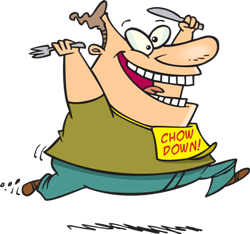Punctuation Marks in English
Rules and Examples
Punctuation marks are an important part of English grammar and writing.
Click Here for Step-by-Step Rules, Stories and Exercises to Practice All English Tenses
What are punctuation marks?
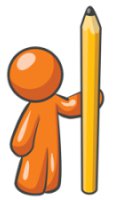 A punctuation mark is a mark (sign) used in writing to divide texts
into phrases
and sentences.
A punctuation mark is a mark (sign) used in writing to divide texts
into phrases
and sentences.Some common punctuation marks are:
- period (full stop) ( . )
- comma ( , )
- question mark ( ? )
- exclamation mark ( ! )
- colon ( : )
- semicolon ( ; )
- single quotation marks ( ' ' )
- double quotation marks ( " " )
- parentheses ( ), brackets [ ] and braces { }
- hyphen ( ‐ )
- en dash ()
- em dash ( )
- ellipsis (. . . )
- apostrophe ( ' )
- slash ( / )
Some additional punctuation marks are:
- ampersand ( & )
- asterisk ( * )
- at sign ( @ )
- bullet ( )
- degree symbol ( ° )
- number sign ( # )
- percent sign ( % )
- underscore symbol ( _ )
- copyright symbol ( © )
- registered trademark symbol ( ® )
- trademark symbol ( )
- dollar sign ( $ )
English punctuation rules
Click on the individual punctuation marks for more information and
examples.
To end a sentence
- period (full stop) ( . )
- question mark ( ? )
- exclamation mark ( ! )
- ellipsis (. . .)
To separate phrases or items
To begin a list
- colon ( : )
To quote or indicate a title
- single quotation marks ( ' ' )
- double quotation marks ( " " )
To indicate extra information
- parentheses ( ), brackets [ ] and braces { }
- em dash ( )
To show alternatives
- slash ( / )
Read also
Example
Sentences with Semicolons ( ; ) | Connecting Thoughts Correctly
Comma
Splices
Illustrated
Worksheet on Punctuation Marks in English
Why is punctuation important?
When we speak, we can pause or emphasize certain words and phrases to help people understand what we are saying.In our writing, we use punctuation to show pauses and emphasis. Punctuation marks help the reader understand what we mean.
A punctuation mark is a mark, or sign, used in writing to divide texts into phrases and sentences and make the meaning clear.
In this lesson, we will look at some common punctuation marks and mistakes. You will see examples of what happens if you omit or misuse some common punctuation marks.
End Punctuation
End Punctuation is the most common punctuation in the English language. You must use end punctuation at the end of every sentence to avoid confusion.The three most common ways to end a sentence are
- period
( . )

The elephant is big.
- question
mark ( ? )
Where is the man?
- exclamation
mark ( ! )
The huge elephant sat on the man!
Here is a paragraph without end punctuation:
Do you like to sing My mom and I
sing in a choir that meets every Tuesday Last week we sang
Christmas carols at a nursing home The residents of the nursing
home enjoyed our visit It was fun Would you like to join us next
Tuesday
You can see that it is very difficult to read and make sense of the paragraph. Every sentence runs straight into the next sentence.
Here is the same paragraph with end punctuation:
Do you like to sing? My mom and I
sing in a choir that meets every Tuesday. Last week, we sang
Christmas carols at a nursing home. The residents of the nursing
home enjoyed our visit! It was fun! Would you like to join us next
Tuesday?
Now, you can see questions, statements, and exclamations in the paragraph. You can see that the writer is excited about singing and enjoyed singing for the residents of the nursing home. The writer also asks if you like singing and would like to join their choir.
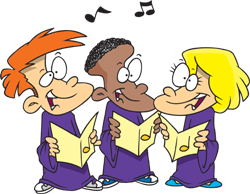
Incorrect uses of end punctuation
Using the wrong end punctuation can cause confusion for the reader.Consider these three sentences:
1.
Richard wants to marry Rose.
2. Richard wants to marry Rose!
3. Richard wants to marry Rose?
2. Richard wants to marry Rose!
3. Richard wants to marry Rose?
The words of each sentence are the same, but the end punctuation greatly changes the meaning:
1.
Richard wants to marry Rose.
By using a period, the writer is simply stating a fact. The writer does not show any feelings about the situation.
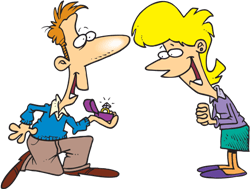 2.
Richard wants to marry Rose!
2.
Richard wants to marry Rose!
With an exclamation mark, the writer shows emotion about the situation. The writer is probably excited.
3. Richard wants to marry Rose?
By using a question mark, the writer has turned the sentence into a question. The writer seems surprised and is asking for clarification.
By using a period, the writer is simply stating a fact. The writer does not show any feelings about the situation.
 2.
Richard wants to marry Rose!
2.
Richard wants to marry Rose!With an exclamation mark, the writer shows emotion about the situation. The writer is probably excited.
3. Richard wants to marry Rose?
By using a question mark, the writer has turned the sentence into a question. The writer seems surprised and is asking for clarification.
Commas
Commas are another very important type of punctuation. Commas
tell the reader where to pause. Commas also separate phrases, ideas,
and items in a list. Commas help avoid confusion.A) Using commas in lists:
Here
is a list without
commas:
Sally likes to eat chocolate hot dogs and broccoli.


Without commas, it sounds like
Sally likes to eat hot dogs and broccoli covered
in chocolate!
Yuck!
Yuck!
Here is the same list with commas:
Sally likes to eat chocolate, hot dogs, and broccoli.
Now, we see that Sally actually likes three foods:
1. chocolate
2. hot dogs
3. broccoli
Now, we see that Sally actually likes three foods:
1. chocolate
2. hot dogs
3. broccoli
B) Commas for phrasing
Here is another funny example:1.
It is time to eat David!
2. It is time to eat, David!
2. It is time to eat, David!
1. In the first sentence, it sounds like we are going to eat David for lunch!
2. The comma in the second sentence shows the writer that we are actually informing David that it is time to eat.
Quotation marks
Quotation marks are another common punctuation mark in the English language. Quotation marks are used with commas to inform the reader that someone is talking or being quoted.Example:
"Punctuation
is
important," my teacher said. "Without punctuation marks, your
writing would be very confusing."
Without quotation marks and commas, it would be difficult to understand what the character is saying.
Punctuation
is
important my teacher said without punctuation marks your writing
would be very confusing
Quotation marks are also very important when you are quoting words someone has already said.
Example:
Maya
Angelo
said, "If you don't like something, change it. If you can't
change it, change your attitude."
Maya Angelo is a famous author and poet. When I am quoting her, I show her exact words by enclosing them in quotation marks. By using quotation marks, I am giving her credit for her words.
Apostrophes
Apostrophes are another commonly misused form of punctuation. Apostrophes are used to show ownership and missing letters in contractions.Misplaced apostrophes can cause confusion for readers.
Example:
it's = it is
its = ownership
- Correct:
The
dog sleeps in its house.
The house belongs to the dog.
The house belongs to the dog.
- Incorrect:
The
dog sleeps in it's
house.
This does not make sense because we would not say, "The dog sleeps in it is house."
This does not make sense because we would not say, "The dog sleeps in it is house."

boy's = ownership
boys = more than one boy
- Correct:
The boy's room is painted blue.
The blue room belongs to the boy.
- Incorrect:
The boys room is painted blue.
In this example, we do not know if the room belongs to one boy (boy's) or more than one boy (boys').
- Correct:
The boys are sleeping in the tent.
There is more than one boy sleeping in the tent.
- Incorrect:
The boy's are sleeping in the tent.
The apostrophe is not needed in this sentence because we are not showing ownership.
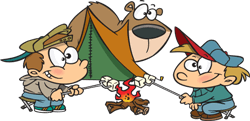
A final note about punctuation
These were just a few examples of the importance of using punctuation in our writing.It is important to use punctuation correctly to help the reader understand our writing.
Without punctuation, our writing would be a confusing mess!
These were examples of the importance of punctuation. Now that you know them, it is time to practice! Read and do exercises.
Get Updates, Special Offers, and English Resources
Download your FREE GIFT (the first two chapters of
English Short Stories Book and Workbook)
as soon as you join!

By submitting your email, you consent to receiving updates and newsletters from us and to the sharing of your personal data with third parties for the purposes of sending you communications. We will not spam you. You can unsubscribe at any time. For more information, please see our privacy policy.
Return from Punctuation Marks in English to Easy English Grammar
Return from Punctuation Marks in English to Write in English

